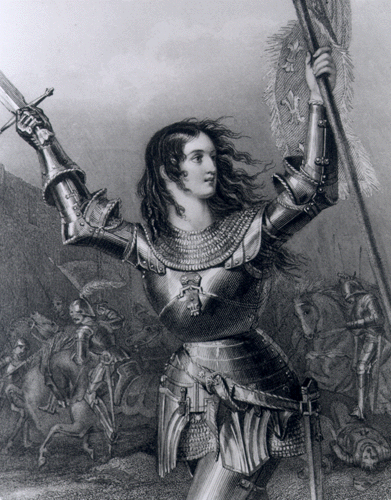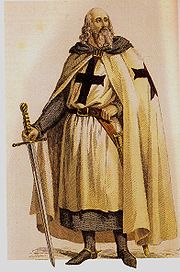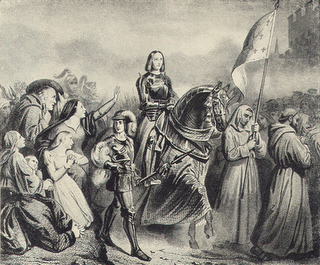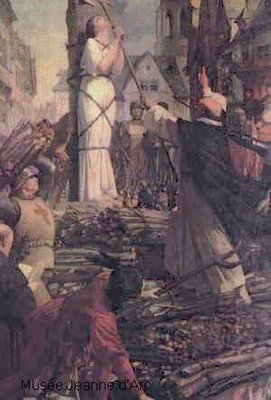 There are probably as many interpretations of the life of the Maid of Orleans as there are historians. Joan of Arc has not always been portrayed as a heroine. Artists and writers have depicted her as vicious, a strumpet, ugly, bloodthirsty, or psychologically unbalanced. Others have seen her as a nature lover, a revolutionist, a proto-feminist, or misguided religious mystic. The reason for the disparity in the accounts of Joan of Arc’s life is that there was little written evidence of the events of her time. The records of her trial were neglected for over four hundred years.
There are probably as many interpretations of the life of the Maid of Orleans as there are historians. Joan of Arc has not always been portrayed as a heroine. Artists and writers have depicted her as vicious, a strumpet, ugly, bloodthirsty, or psychologically unbalanced. Others have seen her as a nature lover, a revolutionist, a proto-feminist, or misguided religious mystic. The reason for the disparity in the accounts of Joan of Arc’s life is that there was little written evidence of the events of her time. The records of her trial were neglected for over four hundred years.
Along with the paucity of evidence was the fact that many did not know how to interpret the claims made by Joan that she heard “voices”. Was she really visited by St. Catherine, St. Margaret, and Michael the Archangel? Was she a sincere, devout follower of Christ, who really believed she heard voices? Or was she delusional?
All agree that she was a courageous French peasant girl who led an army to victory to save her country during the reign of a weak king. She was captured by the enemy and put on trial. She defended herself brilliantly in spite of the fact that all of the charges and evidence were rigged against her. She was barely nineteen years old when she was burned at the stake as a witch and a heretic. Twenty years later, she would be exonerated. It would be another 470 years before the church would declare her to be a saint.
The background to this story is the sad history of France during this time. For nearly three and a half centuries, from around 1000 AD until the mid 1300’s, France had grown from a collection of small fiefdoms to the mightiest monarchy in medieval Europe. Then began a rapid downfall.
Many believe that it all began with a curse. The last Grand Master of the Knights Templar, Jacques de Molay, was burned to death by the French king Philip IV, (also known as Philip the Fair). Philip was hoping to confiscate the wealth of the Templars, by destroying the last of their order. As the flames and smoke encircled Jacques de Molay, he screamed out a curse against Philip IV, Philip’s descendants, Pope Clement V, and finally all of France. Within two years Philip, his sons and the pope were dead. Within twelve years all of Philip’s descendants, who could have claimed the throne, were dead. A great famine began in France, lasting seven years and killing millions. The Black Death struck in the 1340’s, wiping out a large part of the population.
Templar, Jacques de Molay, was burned to death by the French king Philip IV, (also known as Philip the Fair). Philip was hoping to confiscate the wealth of the Templars, by destroying the last of their order. As the flames and smoke encircled Jacques de Molay, he screamed out a curse against Philip IV, Philip’s descendants, Pope Clement V, and finally all of France. Within two years Philip, his sons and the pope were dead. Within twelve years all of Philip’s descendants, who could have claimed the throne, were dead. A great famine began in France, lasting seven years and killing millions. The Black Death struck in the 1340’s, wiping out a large part of the population.
Within a few more years, the Hundred Years’ War began. There was a dispute over the crown of France by Philip’s nephew, a French nobleman, and Philip’s grandson, Edward III, who was the king of England. Each of these men was certain that he should be the king of France. The English and French began the war that was still going on when Joan of Arc entered the scene.
In 1429, the English had the ascendancy in France. They had won many battles and held much territory. The French dauphin, Charles, was a small, weak, and fearful man. He also had a fatalistic outlook on life. He attended mass and took communion every day. He believed a prophecy which had been going around that stated that France had been ruined by a woman (a reference to his mother probably) and would be saved by a woman.
It was while he was in this frame of mind that he was approached by a seventeen year-old girl, Jeanne d’Arc (Joan of Arc in English). She told him that voices had spoken to her, telling her to free the French from the English and to see to it that the dauphin was crowned king. Charles wasn’t sure what to think of her. The story of how he disguised himself in order to test her is very famous. She not only recognized him, but she told him things that only he and God could know. Charles invited her to stay at the castle and undergo an examination by his counselors. It was poetic justice that the room she stayed in was the very same tower where Jacques de Molay had been incarcerated 115 years before. Joan was fully examined by ecclesiastics, and declared to be sound.
She was given a horse and some armor including a helmet. The Duke of Alencon helped her practice some military skills. Soon Joan was ready to lead the French army against the English.
The most strategic spot in France was Orleans. If this city fell, the way was open for the English to push southward and finish conquering all of France. The English had set up a siege against Orleans. How surprised they must have been in the spring of 1429 to see the French army coming at them from behind, led by a small figure carrying only a battle-ax and riding on a black horse.
Then an amazing thing happened. The English lined up as if to attack Orleans, but  just marched away instead. Orleans had been freed! Later this retreat would be acclaimed a miracle by the French. A victorious Joan entered the city of Orleans to loud proclamations of praise and thanksgiving. The English however would blame the fact of their loss on witchcraft. The English commander told his king, “A great mischief” had befallen his soldiers, caused by “that limb of Satan, named the Pucelle, who made use against them of false enchantments and sorcery.” These accusations of witchcraft would be relied on heavily later at Joan’s trial.
just marched away instead. Orleans had been freed! Later this retreat would be acclaimed a miracle by the French. A victorious Joan entered the city of Orleans to loud proclamations of praise and thanksgiving. The English however would blame the fact of their loss on witchcraft. The English commander told his king, “A great mischief” had befallen his soldiers, caused by “that limb of Satan, named the Pucelle, who made use against them of false enchantments and sorcery.” These accusations of witchcraft would be relied on heavily later at Joan’s trial.
After this victory, Joan went to Chinon to get the dauphin to take him to Rheims to be crowned king in order to fulfill the second command given to her by the voices. Charles was reluctant, but finally went with her to Rheims for his coronation. Along the way they defeated some more English troops, causing the French nobles to pledge their full allegiance to Charles. He was crowned at Rheims on July 12 as Charles VII.
But Joan had been given a third objective by the voices – to free Paris. Joan and the French army arrived at Paris on September 8. The city was assaulted for twelve hours. Joan received a wound in her thigh. The next day, Charles ordered a retreat, thereby thwarting Joan’s third and final task.
The following spring, Charles ordered Joan to go to Compiegne to protect it from an English threat. It was during a battle there that Joan was captured and taken to Rouen to face trial. Charles made no attempt to rescue her or even to ransom her, a procedure that was very common in those days. It has been said that he was jealous of her victories and her fame.
The English were reluctant to put Joan to death because they did not want to create a martyr around which the French might rally. So the commander, Bedford, released her to the French for an ecclesiastical trial for heresy. The trial, which took place between March and May, 1441, was a total fraud.
To understand how dastardly this was, one must understand the politics in the church. The faculty at the University of Paris considered itself to be the premier center for theological and ecclesiastical thought. The Papal schism, which had lasted for over forty years, had finally been resolved. An Anglo-French monarchy would allow the Paris school great preeminence among European colleges. They would lose this prestige if France became united. Joan was in favor of a united France. So the Parisian theologians decided that Joan must die.
Detailed accounts of Joan’s trial can be found in many books. It is fascinating reading. The main emphasis here is about her courage. No matter what lies were told about her, no matter how she was threatened, Joan refused to recant her faith. She had one weak moment when shown the stake at which she was to be burned. Later, however, she repented of that.
On May 30, 1431, Joan’s head was shaved and she was forced to wear a paper hat on which were written, “Heretic, Relapsed, Apostate, Idolater.” She was taken to the main square in Rouen where a large crowd had gathered. After she was lashed to the pole and the fagots were lit, she called out, “Jesus, Jesus, Jesus . . .” Then Joan, the Maid of Orleans, died at age nineteen.
which were written, “Heretic, Relapsed, Apostate, Idolater.” She was taken to the main square in Rouen where a large crowd had gathered. After she was lashed to the pole and the fagots were lit, she called out, “Jesus, Jesus, Jesus . . .” Then Joan, the Maid of Orleans, died at age nineteen.
Many believe that her brave death was a turning point in the life of Charles VII. The heretofore timid, cowardly king suddenly became confident and led his people to win many battles. He actually is known in history today as “Charles the Victorious”. The French went on the push the English out of their country for the most part; only the port of Calais remained in English hands. Truly it was Joan who had turned the tide for the French, eventually ending the curse of Jacques de Molay.
What are we as Christian women to make of Joan? Was she truly a believer who now enjoys eternal life with Christ? Was she a misguided religious dreamer? Will we be able to talk to her when we get to Heaven? I don’t know but I hope so.

